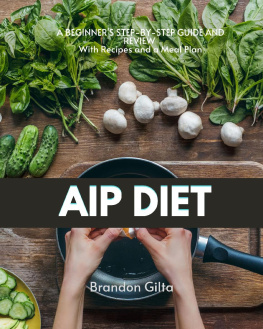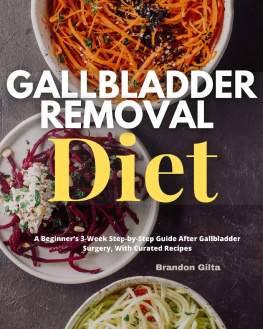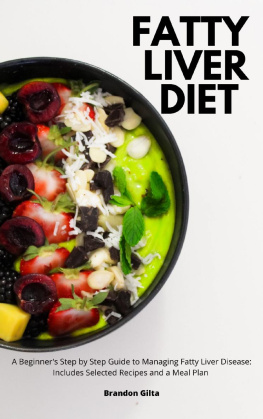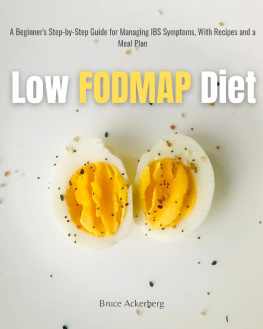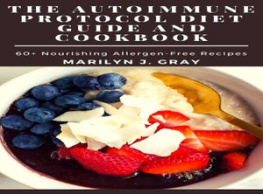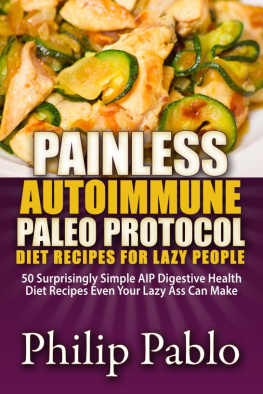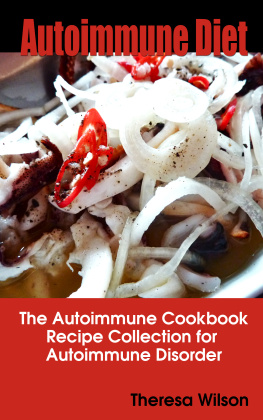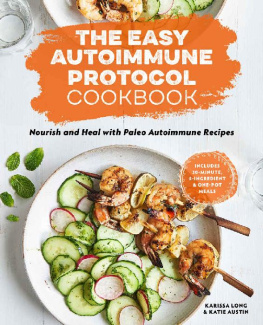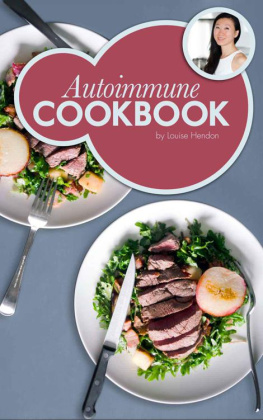Brandon Gilta - AIP (Autoimmune Protocol) Diet
Here you can read online Brandon Gilta - AIP (Autoimmune Protocol) Diet full text of the book (entire story) in english for free. Download pdf and epub, get meaning, cover and reviews about this ebook. year: 2020, publisher: mindplusfood, genre: Home and family. Description of the work, (preface) as well as reviews are available. Best literature library LitArk.com created for fans of good reading and offers a wide selection of genres:
Romance novel
Science fiction
Adventure
Detective
Science
History
Home and family
Prose
Art
Politics
Computer
Non-fiction
Religion
Business
Children
Humor
Choose a favorite category and find really read worthwhile books. Enjoy immersion in the world of imagination, feel the emotions of the characters or learn something new for yourself, make an fascinating discovery.
- Book:AIP (Autoimmune Protocol) Diet
- Author:
- Publisher:mindplusfood
- Genre:
- Year:2020
- Rating:3 / 5
- Favourites:Add to favourites
- Your mark:
- 60
- 1
- 2
- 3
- 4
- 5
AIP (Autoimmune Protocol) Diet: summary, description and annotation
We offer to read an annotation, description, summary or preface (depends on what the author of the book "AIP (Autoimmune Protocol) Diet" wrote himself). If you haven't found the necessary information about the book — write in the comments, we will try to find it.
AIP (Autoimmune Protocol) Diet — read online for free the complete book (whole text) full work
Below is the text of the book, divided by pages. System saving the place of the last page read, allows you to conveniently read the book "AIP (Autoimmune Protocol) Diet" online for free, without having to search again every time where you left off. Put a bookmark, and you can go to the page where you finished reading at any time.
Font size:
Interval:
Bookmark:
AIP (Autoimmune Paleo) Diet
A Beginner's Step-by-Step Guide and Review
With Recipes and a Meal Plan
Copyright 2019 Brandon Gilta
All rights reserved. No portion of this book may be reproduced in any form without permission from the publisher, except as permitted by U.S. copyright law.
Disclaimer
By reading this disclaimer, you are accepting the terms of the disclaimer in full. If you disagree with this disclaimer, please do not read the book. The content in this book is provided for informational and educational purposes only.
This book is not intended to be a substitute for the original work of this diet plan. At most, this book is intended to be beginners supplement to the original work for this diet plan and never act as a direct substitute. This book, is an overview, review, and commentary of the facts of that diet plan.
All product names, diet plans, or names used in this book are for identification purposes only and are property of their respective owners. Use of these names does not imply endorsement. All other trademarks cited herein are property of their respective owners.
None of the information in this book should be accepted as independent medical or other professional advice.
The information in the books has been compiled from various sources that are deemed reliable. It has been analyzed and summarized to the best of the Author's ability, knowledge, and belief. However, the Author cannot guarantee the accuracy and thus should not be held liable for any errors.
You acknowledge and agree that the Author of this book will not be held liable for any damages, costs, expenses, resulting from the application of the information in this book, whether directly or indirectly. You acknowledge and agree that you assume all risk and responsibility for any action you undertake in response to the information in this book.
You acknowledge and agree that by continuing to read this book, you will (where applicable, appropriate, or necessary) consult a qualified medical professional on this information. The information in this book is not intended to be any sort of medical advice and should not be used in lieu of any medical advice by a licensed and qualified medical professional.
Always seek the advice of your physician or another qualified health provider with any issues or questions you might have regarding any sort of medical condition. Do not ever disregard any qualified professional medical advice or delay seeking that advice because of anything you have read in this book.

Table Of Contents
I want to thank you and congratulate you for getting this guide.
If you are struggling with autoimmune diseases such as rheumatoid arthritis you might be curious about alternative ways of managing your symptoms.
While medications may dull chronic pain, they sometimes come with unpleasant side effects. Also known as the autoimmune protocol diet, the autoimmune paleo (AIP) diet offers one way of helping reduce your symptoms by addressing one of their potential causes.
The AIP diet provides people with autoimmune diseases an opportunity to manage chronic pain by eliminating specific type of foods that are thought to cause or worsen inflammation throughout the body. In addition, the diet also incorporates many different types of food that could help reduce joint inflammation and soothe pain, including those rich in healthy omega-3 fatty acids. Some patients have reported a reduce the need for their pain medications and significant improvements in their quality of life.
This book provides a comprehensive and concise look at the benefits of the AIP diet and offers a step-by-step guide for meal planning. It also judges the merits of the diet based on the available evidence and shares a few important steps to remember when trying this diet.
Thanks again for getting this book. I hope you enjoy it!
Identified as a variant of the much more familiar paleo diet, the AIP diet employs a much more refined and restrictive approach to meal planning. The AIP diet is focused on preventing and addressing leaky gut syndrome. Certain types of food are thought to contribute to the disorder, which can lead to or worsen the progression of autoimmune diseases, among them rheumatoid arthritis.
Both paleo diet and the AIP diet were based on the work of Dr. Loren Cordain, PhD, who believed that a diet low in carbohydrates and rich in vegetables, proteins, and healthy sources of fat are closer to humans natural diets and thus significantly healthier for the human body.
Further developments on the AIP diet were made by author Robb Wolfe, who outlined it as an elimination diet, and Dr. Sarah Ballantyne, PhD, who did extensive research on the science behind it. Dr. Ballantyne discussed the diet and its benefits extensively in her book The Paleo Approach.
Because it did not involve cutting out many popular meat dishes, the paleo diet became a popular way of managing weight. This isnt just your average weight loss diet; it is meant to be part of a comprehensive pain management strategy that aims to address leaky gut syndrome.
In her website, Dr. Ballantyne outlines the major difference between the two diets: while the AIP diet takes on a similar nutrients-first approach to food selection to other diets, it also focuses on avoiding the types of food that could indirectly trigger inflammation.
The Principles Behind the Diet
In general, paleo diet rejects many of the foods that were only commonly available after the invention of agriculture. This not only includes all processed foods but also sugar, grains, and dairy products. Some of the foods commonly eaten in the paleo diet include the following:
Lean meats
Fish
Vegetables
Seeds and nuts
Fruits
Oils derived from nuts and fruits
As a variant of the paleo diet, the AIP diet follows similar restrictions, but adds more foods and forbids others. The foods encouraged or restricted are based on how they affect the gut lining. By cutting back on food that irritates the gut lining, you allow your gut to heal naturally and bring your intestinal gut flora back into balance.
Among the foods to avoid in this diet include eggs, legumes, alcohol, artificial sugar substitutes, vegetables and fruits from the nightshade family (such as potatoes, chili peppers, eggplants, and tomatoes), coffee, and chocolate. In addition, you may need to abstain from specific medications, such as nonsteroidal anti-inflammatory drugs and supplements that incorporate chlorella, spirulina, and other blue green algae.
Some of the foods encouraged in this diet plan include the following:
Non-seed herbs (such as oregano, basil, rosemary, and mint)
Offal and organ meats
Bone broth
Sweet potatoes
Coconut milk
Green tea and non-seed herbal teas
Non-dairy fermented foods (such as kimchi and kombucha)
Bone broths
Vinegar
Nature-derived sugars such as maple syrup and honey, in sparing amounts
Probiotic-rich foods
Meal plans based on paleo diet are often quite healthy, due to the abundance of vegetables, and healthy fats. Findings also show that following the paleo diet offers many health benefits, including greater weight loss and a significant improvement in both glucose tolerance and blood pressure control.
Besides sharing many of the paleo diets benefits, the AIP diet offers a host of other benefits for people with inflammatory diseases. Although research into its effectiveness is still in its infancy, scientists and patients alike have so far found positive results. One small preliminary study in 2017, published in the journal
Font size:
Interval:
Bookmark:
Similar books «AIP (Autoimmune Protocol) Diet»
Look at similar books to AIP (Autoimmune Protocol) Diet. We have selected literature similar in name and meaning in the hope of providing readers with more options to find new, interesting, not yet read works.
Discussion, reviews of the book AIP (Autoimmune Protocol) Diet and just readers' own opinions. Leave your comments, write what you think about the work, its meaning or the main characters. Specify what exactly you liked and what you didn't like, and why you think so.

